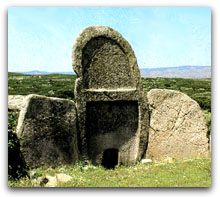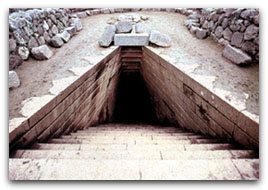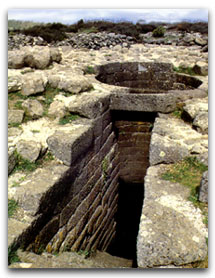The picture of the rich and
fashionable nuragic civilisation will be complete with a visit to some of the characteristic
tombs of this period, the so called "Tombe dei Giganti" (Tombs of Giants) the name of which
comes from popular fantasy created by the majestic nature of these collective
tombs.
|
Moreover their layout with its long
covered corridor for burials with, at the front, its two semicircular arms that form an open
space for the burial rites, evoke the stylised figure of a bull's head with long arched horns,
that are a clear religious symbol. In the countryside around Dorgali are some of the most
interesting and well preserved examples, in which the characteristic stele with its small
door (to pass into the afterlife?) that marks the entrance to the burial corridor can be
appreciated. It is also worth seeing the tombs in the area of Paulilatino, with the majestic
example of Goronna, that can be reached via the SS 131.
|
|

 Dorgali - S'Ena 'e Tomes Dorgali - S'Ena 'e Tomes
Tomba di giganti |

 Paulilatino - The well temple of Santa Cristina Paulilatino - The well temple of Santa Cristina |
|
In the area of Paulilatino, which is
particularly rich in ancient ruins, in the area of the village-sanctuary of Santa Cristina is one
of the finest and most elegant of the well temples. It is characteristic of the temples
where "the cult of the water" was worshipped during the nuragic period. There are about 40
holy wells in Sardinia. They are formed by a circular room with a tholos, that are partially
buried and have a terrace that slopes down to the fertilising water spring. Sometimes they are
found standing alone in the countryside or are joined to villages and are often at the centre of
real sanctuaries.
|
An example is the well temple of
Santa Vittoria, inside a great complex in the North-Western extremity of the Giara, in the
area of Serri. Pilgrims used to come from all over the Island to this Sanctuary as can be seen
from the Sanctuary's architectural richness. Beside the buildings for cult worship and the
accommodation for priests and believers, there were communal spaces where the headmen
held meetings and spaces for markets, singing and dances.
The religiousness of the nuragic people is also shown by other cult temples, the so called
megaron temples, of which very few examples are known, like the two temples of Serra Orrios
in Dorgali and the megaron in Esterzili. These sacred places are reminiscent of similar Greek
buildings with their long rectangular layout and doubled entrance "in antis" and testify to
contacts with the Aegean World, which has been confirmed by the finding of Mycenaean
ceramics in nuragic contexts.
|
|

 Serri - The well temple of Santa Vittoria Serri - The well temple of Santa Vittoria |
|